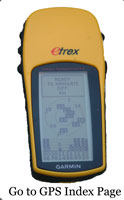 Modelling of GPS accuracy for distance measuring
Modelling of GPS accuracy for distance measuring  Modelling of GPS accuracy for distance measuring
Modelling of GPS accuracy for distance measuring In the article Repeatability of Marked Way Points I have reported the spread of repeat measurements of a fixed point. The data closely fits a Rayleigh distribution with a parameter of 3.3 m. In the article on the Rayleigh distribution. I show that this is equivalent with a normal or Gaussian) spread of errors in each of the two perpendicular grid coordinates, Eastings and Northings. The standard deviation of these two normal distributions is identical and is 2.33 m. This is derived by calculating 3.3/sqrt(2).
I am going to simulate the measurement with my GPS of some different configurations for a 10k race course. I have chosen only simple configurations consisting of a small number of straight lines. I will assume that these have been laid out precisely and I measure the coordinates of the corners of the courses by recording their coordinates with the GPS. I assume the East and North coordinates of each corner has errors normally distributed about the correct value with a standard deviation 2.33 m.
In order to model the effect of GPS errors on course measurements I am going to consider a series of 10 km courses made up straight line legs as follows:
For course 2 to 8 where the course start and finish are at point I have nevertheless assumed that separate measurements are needed for both the start and the finish. This will replicate how a measuring device is used on a bicycle which is ridden from start to finish with the readings taken at start and finish to determine the distance travelled along each leg.
I have carried these simulations out on a spreadsheet.
Taking Course 4, the square, as an example.
I assume it is laid out as follows:
Eastings (m) |
Northings (m) |
|
|---|---|---|
start |
0 |
0 |
corner 1 |
2500 |
0 |
corner 2 |
2500 |
2500 |
corner 3 |
0 |
2500 |
finish |
0 |
0 |
On my spread sheet I then modify the coordinates by adding random errors with a standard deviation of 2.33 m. Here is an example on one modified set of locations
Eastings (m) |
Northings (m) |
|
|---|---|---|
start |
-0.59 |
0.62 |
corner 1 |
2498.35 |
1.38 |
corner 2 |
2505.39 |
2499.88 |
corner 3 |
1.9 |
2506.33 |
finish |
5.07 |
0.73 |
Next on my spreadsheet using Pythagoras I calculate the distance between these modified coordinates. For the above example I get a value for the course length 10006.56 m. So for this trial my GPS would give a course length that was long by 6.56 m.
I repeat the above simulation 1000 times on my spread sheet by copying the formula to different spreadsheet row. Next I calculate the standard deviation of the 1000 simulations.
For a set of 1000 simulations I get an average value of 10000.14m and a standard deviation for an individual simulation of 6.72 m
I can repeat the whole set of 1000 simulations by recalculating the spread sheet. my next set gave a mean of 9999.85 m with a standard deviation of 6.27 m.
Recalculating the spread sheet a number of times I noted that on average the standard deviation was about 6.6 m
| Course configuration | Standard deviation of GPS measurement |
|---|---|
| straight line | 3.3 m |
| out & back | 5.8 m |
| equilateral triangle | 6.7 m |
| square | 6.6 m |
| regular pentagon | 6.3 m |
| regular hexagon | 6.1 m |
| regular heptagon | 6.0 m |
| regular octagon | 5.8 m |
For a 10k course the SCPF is 10m. it is generally accepted that course measurers would not be more than 10m in error, when one includes all the course measurers' sources of error. The GPS would need to have an error of about 3.3m to equal the course measurers bikes. This would mean that that the GPS would need to have an error of 3 times its standard deviation which would occur rather rarely. The above table simulated standard deviations for a GPS measurement is around two times worse than would be needed to match course measurers using a calibrated bike and Jones counter.
I have taken the a measured value for the repeatability of way points recorded on my ETREX H, and have simulated measuring a 10k course configured as a regular polygon, with straight straight legs. I have assumed that I have used the GPS to measure the location of each of the corners of the polygon. I predict an accuracy about twice as bad as is obtained by course measurers using calibrated bikes and Jones counters, i.e. An error of more than 20 m for a polygon course of length 10 km would be unlikely.
In my next article, Experimental data for the measurement of the length of the long Tow calibration course with GPS, I examine whether this prediction is born out in practice
Mike Sandford - 1 April 2009